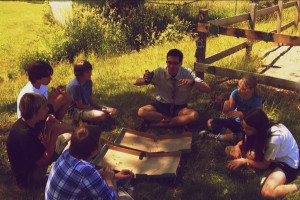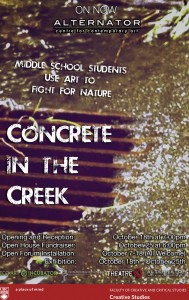How to Flow Upstream: Eco Art Connecting Students with their Learning
Student: SHIMSHON OBADIA
CLICK TO HEAR: CBC Daybreak Interview: Using art to fight for the Environment
CLICK TO SEE: Press Release for Concrete in the Creek Installation
Concrete in the Creek: An eco-art experience
by Shimshon Obadia
Educational tools are all around us. A wetland habitat rich with hands-on educational and artistic possibilities sits in the centre of the École K.L.O. Middle School grounds; it is covered entirely by aging, cracked concrete pads. Working with the school’s students and their dedicated teacher, Michelle Hamilton, over the past five months, we are using eco-art to gain the attention needed to restorethis once luscious wetland.
It is a cool autumn morning on the school grounds of École K.L.O. Middle School, avibrant pumpkin-orange Acer Macrophyllum leaf (the ‘Big Maple Trees’ indigenous to theOkanagan region) drifts with a combination of grace and pre-teenaged awkwardness beforebeing carried along its path by the flow of Fascieux Creek. It is then stopped and torn by coldcracked concrete pads. What was once a luscious wetland, the perfect learning and ecologicalenvironment, has become what I see in front of me now.
This is what Michelle Hamilton and her students have been fighting to change for the pastfive years. Educational prioritizing on shorter school budgets has created a binary choicebetween new classroom sets of laptops and a natural environment conducive to embodiedpractice based learning. The students at K.L.O. were told that they needed one hundredthousand dollars to restore the wetland running through the school grounds. Of this, they haveraised approximately eighty five thousand dollars; this is eighty five thousand dollars not simply handed out for the good of the school, but tirelessly worked for by the students at K.L.O. with the assistance of some invaluable volunteers. But for some reason, money is no longer the only obstacle. This is not your cliché group of middle schooler slactivists. From the moment I beganworking with them, when I was only planning on doing a short-term eco-art project with theschool, I was completely blown away by the dedication they had to their immediate naturalenvironment and how aware they were of the connection between it and their own education. This creek could be an ideal learning ground for every subject from the sciences to the fine arts.
So if the money is only about fifteen thousand dollars away from these students gettingtheir educational habitat restored, why are there still sinking concrete pads covering what was once a beautiful, natural wetland? There are other forces at play here; points of concern haverecently arisen everywhere from the size of the soccer field to the idea of children turned flower- thieves at the sight of fresh, local flora. This is where I come in: working with UBC’s Eco-ArtIncubator, I have been providing art as a means to attract attention to the work these students have been tirelessly committed to, whilst simultaneously providing a creative outlet for theenvironmental concerns directly impacting their education. Our aim is to get a natural learningenvironment conducive to embodied, practice-based learning through building enough support for this project in the community. This is in an effort to get these students what they want andneed; their school’s wetland habitat restored to serve as an outdoor classroom, lab, studio, playground and inspiration. And with the financial support for this natural habitat is nearly inplace, it likely won’t be long before this becomes a reality for these students.
I stand next to the creek in the middle of the school grounds. It is still covered in cold, cracked, sinking concrete pads. I feel the autumn wind brush by my nose and chill my moisteyes as it works its way past my face. I close my eyes and listen to the creek flowing. Now I seea classroom but not a classroom inside a building; I see the classroom underneath the concrete. Desks with slates face each other in a circle on top of the water. Tall trees and Typha Latifolia (local cattails) surround me and I can hear the students’ voices. They are talking about what they want here. I am hearing countless conversations about them wanting and working so longand so hard for this, for their passion; for the investment in their own future not one handed outto them but one that they fought for and could not be happier to have finally received out of theirown sweat.
What I’ve described above is the eco-art installation, Concrete in the Creek. The school desk slates have prompts on them encouraging the audience to contribute their ideas andopinions on the project. These slates are being re-projected via a live feed onto a wall in thegallery. This is done to encourage all members of the community to contribute their ideas andopinions on the current situation at École K.L.O. Middle School and have those ideas andopinions shared with the rest of the community. These desks sit on a large scale water colour painting on cloth which the students at K.L.O. are making of the creek as they envision it beingone day soon. This painting comes from some of the eco-art work I am currently doing withthese students. They each have a very well developed sense of what they would like to see ontheir school grounds one day and it is ultimately their collaboration of their visions that will bringthat into fruition. Using water colour, they are expressing their ideal vision of their future. Treebranches are suspended on wires from the celling and behind them on the remaining threewalls of the gallery is a projection of the creek on Casorso Road close to the school where thehabitat has not been disrupted from its natural state. This puts the classroom directly into thewetland where one can experience an integrated learning environment balanced with thenatural system bring restored at École K.L.O. Middle School. There are children’s voices projected around the space, excerpts from many long recorded conversations we have had that were part of a dialogical performance series we did at the end of their last school year. These are their requests, these are their views, this is how they see the natural environment at their school and how they want to see it.
The set-up and load-in of this installation is a little non-traditional. To show the embodiednature of this project’s process and goals, we are planning on using the first two weeks as aninteractive community installation process. Here, members of the community, including the students contributing to the installation, will be able to come in and observe the progression ofthe virtual-nature-classroom in a style akin to that of an open forum. In this, those observing areinvited to leave their thoughts and opinions in a guest book dubbed the ‘opinions book’ which will be incorporated into the ‘finished product’ version of the show. During this process, the wall designated for the live feed of the slates will be projecting black and white videos of the studentstalking about their reasons for fighting for their natural environment, and why it is so valuable tothem. On the weekend after the second week of this install, the reception launches the ‘finishedproduct’ for the final week where Concrete in the Creek is left up for display and interaction. Here there is information about how those who are interested in supporting the project can do so and donate to it.
The students at École K.L.O. Middle School have reminded me how easy it is to besurprised. I honestly never thought I would see such committed young people working socompletely dedicated to their environment and their education. This is not the generation ofslactivists I come from: this is a generation of action. When these students eventually doremove these old cracked concrete pads, they will have unearthed more than the habitat hiddenin their back yard; they will have revealed hope in a beautiful, luscious wetland to the world inevery step they take forward from it.
KLO Middle School student quotes taken from Shimshon Obadia’s documentary Daylighting Fascieux Creek (working title).
- Most people learn better when they’re outside in nature.
- It helped me connect with nature and know what species are in the area.
- Nature has very positive energy.
- A lot of insects and bugs that are quite enjoyable to watch.
- You can enjoy yourself more.
- Nature is really positive to have at the school because it recharges us positively and so it gets us ready to learn in the classroom because if you’re stuck in the classroom all day it makes it really hard to concentrate. So when you come outside and you experience the creek and all the animals it really recharges you and gets you ready to learn the rest of the day.
- Louv, Richard. Last Child in the Woods. 2nd ed. New York: Algonquin, 2008. Ebook.
- Nicholson, Helen. Applied Drama: the gift of theatre. New York: Palgrave MacMillan, 2005. Print.
- Kester, Grant H. Conversation Pieces. London: University of California Press, 2004. Print.
- Rabiger, Michael. Directing the Documentary. 3rd ed. Oxford: Focal Press, 1998. Print.
- Weintraub, Linda. To Life! Eco Art in Pursuit of a Sustainable Planet. Berkeley, Los Angeles and London: University of California Press, 2012. Ebook.

